This is the website of Abulsme Noibatno Itramne (also known as Sam Minter).
Posts here are rare these days. For current stuff, follow me on Mastodon
|
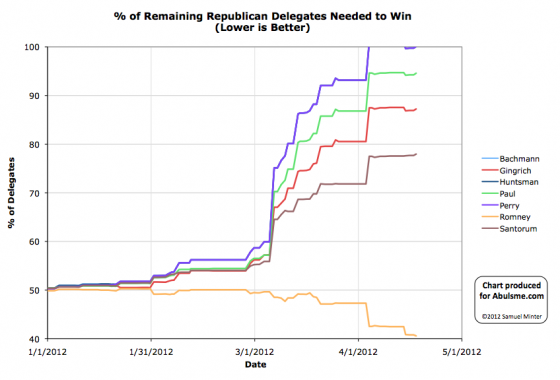
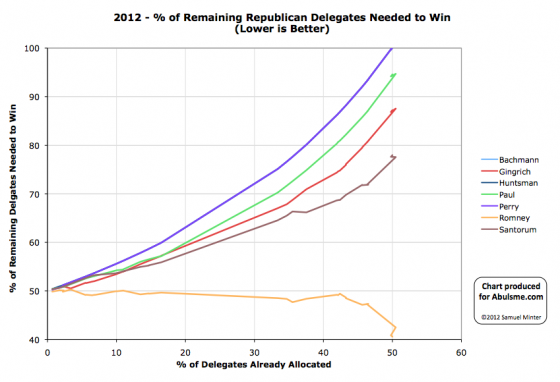
Charts from the Abulsme.com 2012 Republican Delegate Count Graphs page. When a candidate gets down to 0%, they have clinched the nomination. If they get above 100%, they have been mathematically eliminated. The first chart is by date, the second is by “% of Delegates Already Allocated”. These numbers include estimates of the eventual results of multi-stage caucus processes which will be refined as the later stages occur.
Over the last week DCW counted four new Romney superdelegates. Two from New York, one from Colorado, and one from Connecticut.
Four delegates is of course minor at this point and everybody knows the nominee is Romney, but we will continue posting updates until Romney actually gets to 1144. By the estimates I am using, he now has 680.
In terms of “% of remaining needed to win” this update gives us:
- Romney: 40.8% -> 40.6%
- Santorum: 77.7% -> 78.0%
- Gingrich: 86.9% -> 87.2%
- Paul: 94.2% -> 94.6%
This also puts us once again above 50% of the total delegates, which means anybody with no delegates at all is now once again eliminated absent the four candidates above losing delegates from their estimated totals (which can of course happen in various ways). So Bachman, Huntsman and Perrry… sorry about that.
The rest of this post is a note for anybody interested in the nitty gritty details of how I come up with my counts. Everybody else can stop reading now. :-)
When I started producing these charts in January I used Green Papers as my only delegate count source (specifically the soft count).
Very soon after that I realized Green Papers wasn’t including super delegate endorsements, so I started adding in the superdelegate counts from DCW.
Then a bit later on Green Papers started folding in the DCW numbers themselves, so I stopped separately adding them, and just used Green Papers count directly again. Sometimes there would be a day or two delay between DCW adding a Superdelegate and Green Papers incorporating that new information, but that wasn’t too bad.
It seems like Green Papers is getting a bit further behind now though. As of this post they hadn’t yet added the superdelegates DCW added on the 11th, 12th and 16th. So I figure until they catch up, I’ll manually add the DCW numbers again. This update catches us up to DCW’s super delegate count and puts the Romney numbers here slightly ahead of what Green Papers is currently showing.
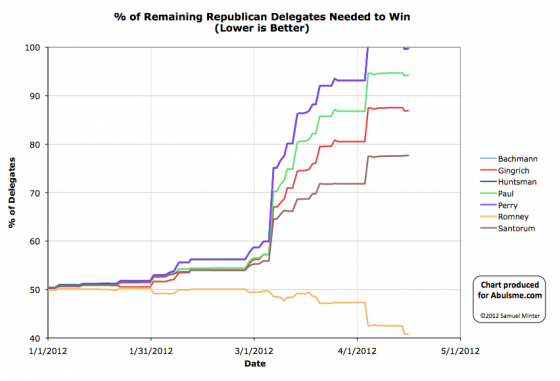
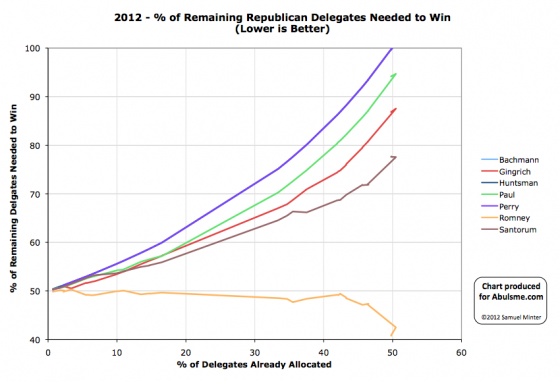
Charts from the Abulsme.com 2012 Republican Delegate Count Graphs page. When a candidate gets down to 0%, they have clinched the nomination. If they get above 100%, they have been mathematically eliminated. The first chart is by date, the second is by “% of Delegates Already Allocated”. These numbers include estimates of the eventual results of multi-stage caucus processes which will be refined as the later stages occur.
Very shortly after my update yesterday, Green Papers updated their Wyoming soft count numbers again. They had been Romney 22, Santorum 2, Paul 1, and 4 TBD. They are now Romney 23, Santorum 2, Paul 1, and 3 TBD. So one of the uncommitted delegates moved to the Romney column. So Romney +1 delegate for the day. Very minor change.
In terms of “% of remaining needed to win”:
- Romney: 40.85% -> 40.80%
- Santorum: 77.61% -> 77.68%
- Gingrich: 86.85% -> 86.92%
- Paul: 94.16% -> 94.25%
- Other: 99.65% -> 99.74%
I believe there are also two New York superdelegates that have come out for Romney that have been tracked by DCW that Green Papers hasn’t added to their totals yet. Since Green Papers now incorporates the DCW numbers, I don’t add them separately as I did in the early days. If I did I’d have to do a lot of extra tracking to avoid double counting, so I’ll wait for Green Papers to add them to their master soft count, which I expect will happen soon.
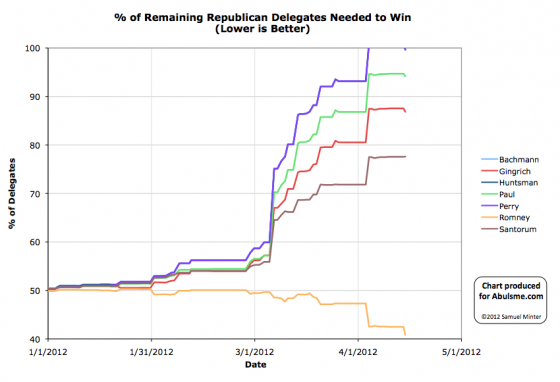
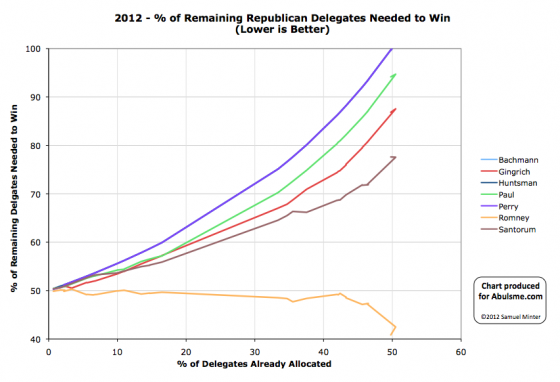
Charts from the Abulsme.com 2012 Republican Delegate Count Graphs page. When a candidate gets down to 0%, they have clinched the nomination. If they get above 100%, they have been mathematically eliminated. The first chart is by date, the second is by “% of Delegates Already Allocated”. These numbers include estimates of the eventual results of multi-stage caucus processes which will be refined as the later stages occur.
Wyoming and Colorado both have caucus type delegate allocation systems, where local caucuses earlier in the year are actually just the start of multi-month multi-stage processes. Both Colorado and Wyoming had their state conventions this weekend finishing off the delegate selection in those states.
Compared to the earlier estimates based on caucus results, the non-Romneys got crushed. Romney gained delegates. Everybody else lost delegates.
This is not surprising. It is common for the “clear winner” to end up taking far more delegates in the end than it looked like they would given the “straw poll” results at the first stage.
Looking more specifically…
- Colorado: The estimates after the caucuses were Santorum 13, Romney 12, Gingrich 4, Paul 4, and 3 uncommitted. This now becomes Romney 13, Santorum 6, and 17 uncommitted. All 36 delegates from Colorado are officially uncommitted, but using the current stated preferences of the delegates we have a net today from Colorado of Romney +1, Gingrich -4, Paul -4, Santorum -7.
- Wyoming: The estimates after the caucuses were Romney 11, Santorum 8, Paul 6, Gingrich 2, and 2 uncommitted. This now becomes Romney 22, Santorum 2, Paul 1, and 4 uncommitted. In Wyoming the delegates are bound. The net for the day in Wyoming is Romney +11, Gingrich -2, Paul -5, Santorum -6
Totaling the day we have Romney +12, Gingrich -6, Paul -9, Santorum -13. This does not look like a good day for the non-Romneys. Especially for Santorum. I guess dropping out of the race doesn’t help one’s ability to compete for delegates.
Notice though that we actually lost 16 delegates from the totals as some delegates that were predicted to go for specific candidates ended up uncommitted to any candidate. This actually increases the pool of potentially available delegates. In theory this improves the situation slightly for Gingrich and Paul, because, hey, they might still convince those uncommitted delegates to vote for them. (And indeed, some reports say many of those uncommitted delegates aren’t ready to support anybody else yet, but are not for Romney at this point either.) Santorum lost enough delegates that his situation actually gets worse anyway.
In terms of “% of remaining delegates needed to win”:
- Romney: 42.49% -> 40.85%
- Santorum: 77.56% -> 77.61%
- Gingrich: 87.54% -> 86.85%
- Paul: 94.70% -> 94.16%
I should also mention, that having these additional 16 delegates not committed brings the total number of delegates allocated by the estimates we use (the Green Papers soft count) back under 50% of the total number of delegates. Which actually means that the candidates with no delegates right now (Bachman, Huntsman, Perry, random others) are now no longer mathematically eliminated, and could catch up and win by capturing 99.65% of the remaining delegates. If they were actually on the ballot on all of the remaining states. Which they are not. :-)
So, uh, anyway… Romney still wins.
In the latest Curmudgeon’s Corner Sam talks about:
- Car GPSes
- Goodbye Santorum
- General Election 2012
- Interpreting Election Coverage
Just click to listen now:
[wpaudio url=”http://www.abulsme.com/CurmudgeonsCorner/cc20120410.mp3″ text=”Recorded 10 Apr 2012″]
or
 1-Click Subscribe in iTunes 1-Click Subscribe in iTunes
 View Podcast in iTunes View Podcast in iTunes
 View XML Feed View XML Feed
|
 |
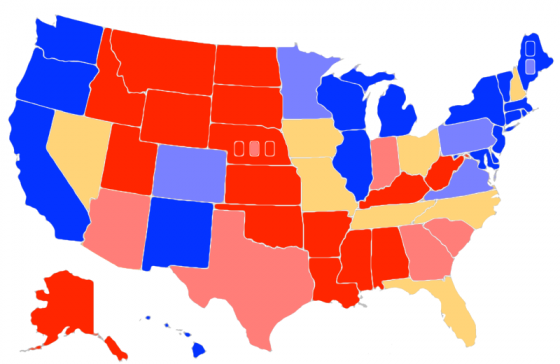
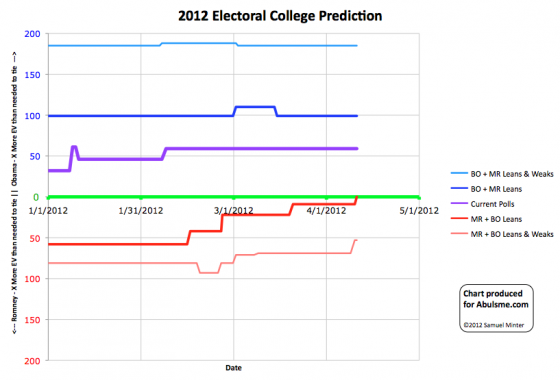
Map and chart from the Abulsme.com 2012 Electoral College Prediction page. Both assume Obama vs Romney with no third party strong enough to win states. Both show the polling situation as it currently exists. Things can and will change before election day. On the map Red is Romney, Blue is Obama, Gold States are too close to call. Lines on the chart represent how many more electoral votes a candidate would have than is needed to tie under several different scenarios. Up is good for Obama, Down is good for Romney.
Just yesterday I was mentioning that at some point things have to stop getting worse for Romney. Yesterday was not that day. Neither is today. Today my poll average for Colorado sees Obama’s lead increase to over 5%. So I color the state light blue and take it out of swing state status.
So, if we give Romney every single one of the remaining swing states… we end up with a 269 to 269 electoral vote tie. In all fairness, ties go to the House and almost certainly that would lead to a Romney win. So Romney can still pull out that very messy win.
But this means that with current polling Romney would not be able to manage a direct win in the electoral college, even in the most favorable disposition of the swing states. That is a remarkably bad position to be in, even this early.
The overall summary looks like this:
|
Romney |
Obama |
| Romney Best Case |
269 |
269 |
| Current Status |
210 |
328 |
| Obama Best Case |
170 |
368 |
Given that, lets compare to four years ago…
On April 11th 2008 if each candidate won every state where they were ahead, McCain would have beaten Obama 283 to 255. He would have won by 28 electoral votes. That is a tight victory in electoral college terms but it is a victory.
Meanwhile, today, if each candidate won every states where they are ahead, Obama would beat Romney 328 to 210. That is a 118 electoral vote margin.
Romney is in a much worse position now than McCain was in four years ago. Of course McCain ended up losing by a pretty substantial margin. So should we all just go home? Obama is going to win, so why bother even having a campaign? No. Not hardly. If we were seeing these numbers in October… then maybe, like I did on October 3rd 2008 when McCain’s best case got this bad, I’d say exactly that. But it is not October. It is April.
Despite McCain’s small lead at this time four years ago the actual election ended up being Obama 365 McCain 173… a 192 electoral vote margin for Obama. So big swings can happen. In 2008 between April 11th and election day 110 electoral votes moved in Obama’s direction. If Romney’s campaign manages to move a similar 110 electoral votes his way… he would win easily.
So even though Obama is way ahead based on today’s polling, the battle has just barely begun. There is a lot more to come.
As our recently departed Senator Santorum would say, “Game On!”
@BreakingNews says Santorum has decided to drop out! It will be interesting to see if he hangs on to his delegates or releases them (those that ate bound anyway, many are not officially bound) and where those delegates end up.
In the end though, this just ratifies the already known result. It is Romney. It has always been Romney.
Update 18:31 UTC: Suspending his campaign, not dropping out. This is the usual course for candidates at this stage. Means they keep their bound delegates (although unbound can of course change their minds and vote for whoever they want) and are able to keep fundraising and such to pay off debts, etc.
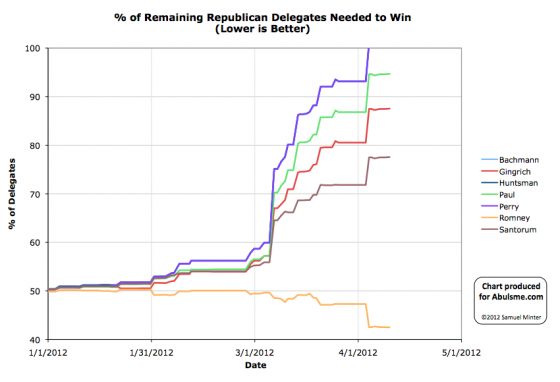
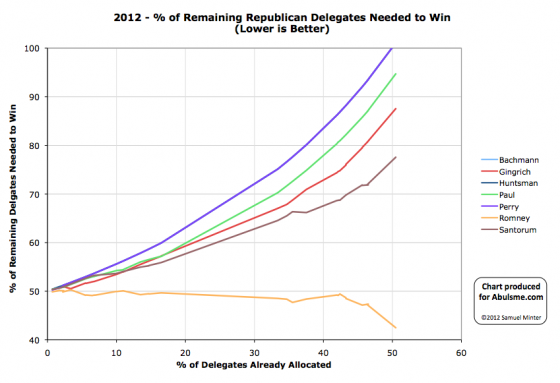
Charts from the Abulsme.com 2012 Republican Delegate Count Graphs page. When a candidate gets down to 0%, they have cinched the nomination. If they get up past 100%, they have been mathematically eliminated. The first chart is by date, the second is by “% of Delegates Already Allocated”. These numbers include estimates of the eventual results of multi-stage caucus processes which will be refined as the later stages occur.
You’d think the remaining superdelegates would be rushing in a mob to get on the Romney bandwagon at this point, but not so far. We have an additional super from Massachusetts today. Well, actually DCW identified the new super on Saturday, but it took Green Papers a few days to update their Massachusetts numbers. Since we go by Green Papers here, we waited. :-)
In any case, this is only one delegate, so only very minor changes to the “% of remaining needed to win” numbers:
- Romney: 42.54% -> 42.49%
- Santorum: 77.49% -> 77.56%
- Gingrich: 87.47% -> 87.54%
- Paul: 94.62% -> 94.70%
And now we continue to yawn and wait in the lull before the next actual contests. Not that there is much contest left anyway, but Romney still does need to mop up the rest of the 1144 delegates he needs.
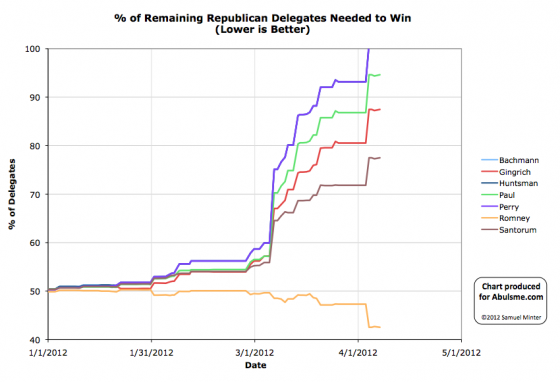
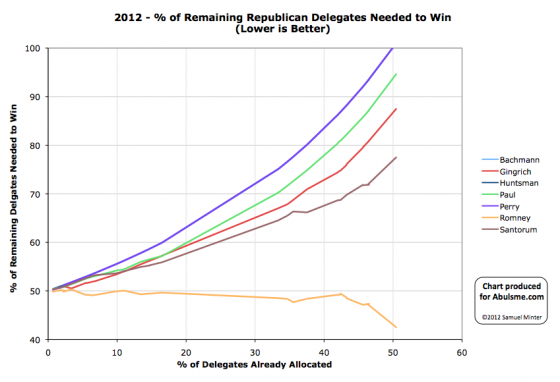
Charts from the Abulsme.com 2012 Republican Delegate Count Graphs page. When a candidate gets down to 0%, they have cinched the nomination. If they get up past 100%, they have been mathematically eliminated. The first chart is by date, the second is by “% of Delegates Already Allocated”. These numbers include estimates of the eventual results of multi-stage caucus processes which will be refined as the later stages occur.
So… remember yesterday when I removed three delegates from Romney’s column because Green Papers decided the three super delegates in Wisconsin were not bound by the primary results? Well, in today’s update they put them back. They are now officially “uncommitted” in their hard count, but are Romney in the soft count (which we use for these charts). The soft count indicates not just the official status, but other indicators of the ways the delegates are likely to vote.
In any case, this reverts things to how they were a couple days ago on our charts.
I’m sure Romney will breathe a lot easier with these three delegates back in his column. :-)
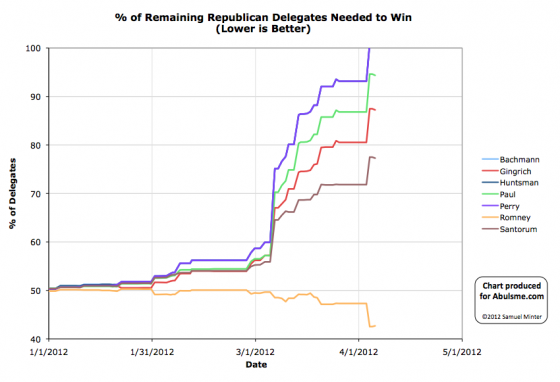
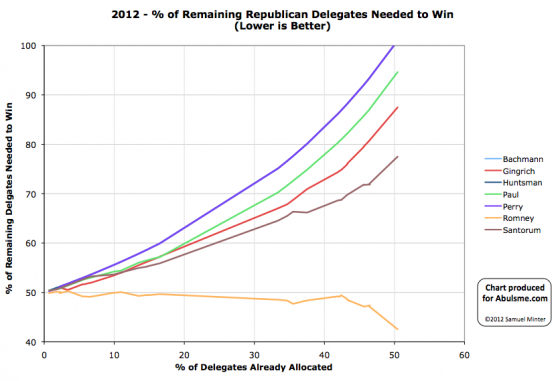
Charts from the Abulsme.com 2012 Republican Delegate Count Graphs page. When a candidate gets down to 0%, they have cinched the nomination. If they get up past 100%, they have been mathematically eliminated. The first chart is by date, the second is by “% of Delegates Already Allocated”. These numbers include estimates of the eventual results of multi-stage caucus processes which will be refined as the later stages occur.
So, Green Papers updated their Wisconsin numbers. They had been 33 Romney, 9 Santorum. They are now 30 Romney, 9 Santorum, 3 still available. Green Papers’ latest update commentary indicates that they had previously thought these superdelegates were bound by the primary results, but it turns out they are not. DCW still says however that those superdelegates are bound by the election results and don’t have independent free choice here, in which case they probably really should be in the Romney column. In fact DCW only made that change on the 4th. So I’m not really sure who is right here.
For purposes of our counts, we go with Green Papers though, so Romney loses the three delegates from his count. If information is found that these superdelegates are bound after all, Green Papers will update accordingly.
The changes to the “% of remaining delegates needed to win” number:
- Romney: 42.5% -> 42.7%
- Santorum: 77.5% -> 77.3%
- Gingrich: 87.5% -> 87.2%
- Paul: 94.6% -> 94.4%
So bad for Romney (since he loses 3 delegates for now) and good for everybody else since these delegates are theoretically now up for grabs again.
But really, this changes nothing.
Romney is the nominee.
Edit 2012 Apr 6 07:07 UTC to refer to both GP and DCW’s views on the 3 superdelegates being bound after I found GP’s comments on this.
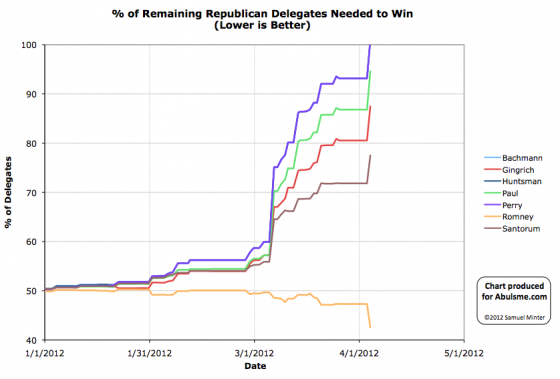
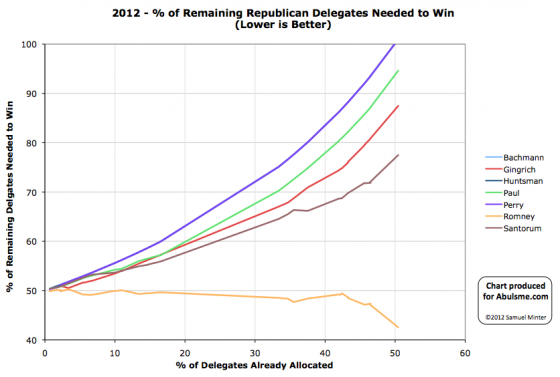
Charts from the Abulsme.com 2012 Republican Delegate Count Graphs page. When a candidate gets down to 0%, they have cinched the nomination. If they get up past 100%, they have been mathematically eliminated. The first chart is by date, the second is by “% of Delegates Already Allocated”. These numbers include estimates of the eventual results of multi-stage caucus processes which will be refined as the later stages occur.
So… this is it. Long ago any realistic possibility for any non-Romney to win the nomination disappeared. With today’s update the already long odds for the non-Romneys to keep Romney from getting to 1144 essentially drop to zero. This is over. Romney wins. Without any sort of brokered convention. For something else to happen now we’d need some event that was so earth shaking that Romney dropped out. This is extremely unlikely.
Details below.
We have updates from four contests. In alphabetical order:
- DC: DC is winner take all, Romney gets all 16 delegates.
- Maryland: Maryland is not actually winner take all, you get some delegates for winning the state, and then more delegates go to the winner of each congressional district. But Romney not only won the state, but every congressional district. So Romney gets all 37 delegates.
- North Dakota: North Dakota had the first round of its process in March. At that time the delegate estimate was Santorum 11, Paul 8 , Romney 7 , Gingrich 2. But the state Republican Convention happened last weekend, and Romney supporters owned the parliamentary process, taking the lion’s share of the delegates despite coming in third in March. That’s how it works in caucus states sometimes. It took a couple days for Green Papers to confirm a new estimate, but it now looks like Romney 20, Santorum 6, Paul 2. So the net today is Romney +13, Gingrich -2, Santorum -5, Paul -6.
- Wisconsin: Wisconsin also allocates some delegates based on both state and CD winners. Romney won the state. Romney won 5 CDs. Santorum won 3 CDs. So overall we have a delegate count of Romney 33, Santorum 9
Add those up and we have a net total for today of Romney +99, Santorum +4, Gingrich -2, Paul -6 Obviously Romney completely dominated the day.
In terms of “% of remaining delegates needed to win” we have this:
- Romney: 47.3% -> 42.5%
- Santorum: 71.8% -> 77.5%
- Gingrich: 80.5% -> 87.5%
- Paul: 86.8% -> 94.6%
The also-rans who left the race early on… Bachman, Huntsman and Perry… are mathematically eliminated after today. Paul, Gingrich and Santorum will inevitably join them soon.
The blocking Romney option? At this point the non-Romneys collectively would need to get 57.5% of the remaining delegates. So far they have managed 42.6% of the delegates. A change of this sort, while not mathematically impossible, would be unprecedented, especially since we are in the phase of the campaign where it is clear Romney is winning and the others are losing. People just stop voting for losers. As things go on, the % of delegates the non-Romneys get will probably actually decline. A major increase is just not going to happen.
It is over.
(We will of course continue to update these charts until Romney actually gets to 1144 however.)
|
|
















